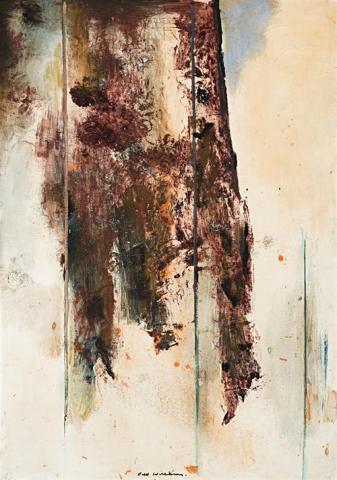SAPLING FOREST, 1962
Fred Williams
oil on composition board
121.5 x 85.0 cm
signed lower centre: Fred Williams
Probably Rudy Komon Gallery, Sydney
The Estate of Pro Hart, Broken Hill, New South Wales
Sapling Forest, 1962, oil on board, 119.5 x 180.0 cm in The Harold E. Mertz Collection of Australian Art, Christie's, Melbourne, 28 June 2000, lot 100
'The story of the Forest series is as much the story of the expansion of Williams 'expressive powers in landscape painting as of growing, formal mastery. Williams explores two opposing interpretations of the bush; airless, sunless and oppressive on the one hand, and on the other, luminous filled with light and heat'
Most of the Forest paintings are worked in warm, earth colours - brilliant ochres, rich browns and siennas, and yellows that almost turn golden at times. After the brooding mysterious image of the forest, these paintings frequently have the shimmer of light and heat. They are vibrant both in colour and touch and celebrate the physical strengths and texture of the bush. From an image of the dark, enclosing forest, Williams opens up the paintings and gives an image of the bush as glowing and light-filled. Williams' confidence visibly returns as the series proceeds'
During the series Williams would frequently explore seeming contradictions. One group takes the abstract geometry of the sapling trunks and makes a whole work from it. Such paintings show Williams aiming for the bones of the landscape where drawing becomes almost schematic in its austerity and abstractness. Yet even those are warmed by his palette which draws so closely on nature.
At the other extreme of the Forest series is a group of works which takes a single image of a tree trunk. Compared with the lightness and delicacy of the geometric paintings, these dense and monumental works emphasise the physical qualities of image and surface alike. Williams worked up the textures of these paintings so that they recall in touch the roughness of bark and wood. He made the whole painting from touch, arguing an almost literal equivalence between the weight and density of paint and the weight and density of the motif. These monolithic images of trunks project a notion of permanence and obduracy, massive forms whose hugeness could only be grasped in fragments. They were products of Williams' intense scrutiny of his motif as he moved his art into close-up, matching his experience of monumental form and effect in nature with an art of similar resonance and substance.
The number of works produced in the Forest series in all mediums reinforces the significance and excitement the painter clearly felt over the period. They resolved so much that he had struggled with over the previous three or four years; drawing and structure were strong, direct and clearly read. He could register his touch freely and abundantly. Landscape was a vehicle of form and could not be read as views or scenes of the bush. Order and energy could be displayed in equal measure; the most radical and innovative side of his art could ride easily and happily with an art of solid, tonal construction.'1
1. McCaughey, P., Fred Williams, Bay Books, Sydney, 1980, pp. 143-45
We are grateful to Lyn Williams for her assistance with this catalogue entry
